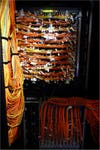New Chinese Supercomputer Goes Beta (Tianhe 2 Ahead Of Schedule And On Budget)
In April 2014, the Tianhe 2 supercomputer began offering computing power to public users while the system continues debugging and...

In April 2014, the Tianhe 2 supercomputer began offering computing power to public users while the system continues debugging and fine tuning. It has a peak processing speed of 33.86 quadrillion floating-point operations per second (petaflops), derived from 16,000 computer nodes, while it has a theoretical peak processing power of 54.9 petaflops. The closest competitor is the Oak Ridge National Lab’s 17.59 petaflops Titan in America, which has only about half of the Tianhe 2’s computing power. Both supercomputers are open to public use for scientific research, including molecular scale physics, climate simulation and astronomic signal processing. Of course, the technology behind these supercomputers could also be used for military purposes, including nuclear weapons test simulations and decryption.

Tianhe 2

Inside the Tianhe 2
The Tianhe 2 remains the world’s most powerful supercomputer as of November 2013, according to industry survey TOP500. The system is a joint effort between China’s National University of Defense Technology (NUDT) and IT manufacturer Inspur, It uses tens of thousands of Intel Xeon CPUs and Chinese FT-1500 core processing units, while NUDT developed its Kylin Linux operating system. Notably (and unlike so many IT and defense projects around the world), the Tianhe 2 went operational in December 2013, well ahead of its 2015 schedule, and reportedly costs only $390 million.

Tianhe 2
Given its unprecedented processing power, Chinese scientists are still brainstorming new applications and missions for the Tianhe 2. The Tianhe 2 is the fruit of Program 863, a Chinese science and technology program started in the 1980s to accelerate research in areas like materials science, information technology and aviation. Other fruits of Program 863 include 62 of the world’s 205 fastest supercomputers, anti-satellite lasers and renewable energy.
PS: Thanks to Kal Sze for clarifying about the Kylin Linux.